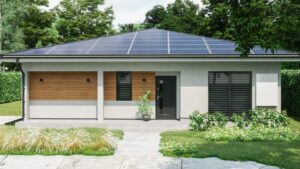As global awareness of climate change increases, homeowners are actively seeking ways to reduce their carbon footprint. Solar energy is a sustainable, renewable source that not only helps the environment but also provides significant financial savings.
This blog serves as a complete guide to help you accurately calculate the size of a solar power system that meets your energy needs, ensuring efficient and effective usage of solar panels. By understanding the sizing process, you can make an informed decision that maximizes your investment.
Getting Started with Solar System Sizing
Estimating Your Electricity Consumption
The first step in sizing your solar system is to assess your energy consumption. Your energy needs are typically measured in kilowatt-hours (kWh). To get a clear picture, gather your electricity bills from the past 12 months. Look for your total electricity usage to find your average monthly consumption.
It’s also helpful to be aware of the energy consumption rates of the various devices in your home. For example, a refrigerator consumes about 200-800 kWh per year, while air conditioners can consume a significant amount during the hotter months.
Calculating Daily Energy Usage
Once you’ve determined your monthly consumption, convert it to daily usage using the following formula:
Example:
If your monthly consumption is 600 kWh:
This daily figure is crucial for determining the solar power you need to generate.
Factors that determine how many solar panels you need
- Peak Sunlight Hours
Peak Sunlight Hours refer to the average number of hours per day when solar panels receive maximum sunlight. This metric varies based on geographical location, climate, and seasonal changes. You can obtain local solar insolation data from online resources or local weather services to understand the average peak sunlight hours in your area.
- Solar Panel Efficiency and System Production
Solar panels’ power output depends on their efficiency ratings and the amount of sunlight they receive. Most residential panels range between 250 to 400 watts. Understanding the efficiency and wattage of the panels you plan to use is essential for estimating your system’s total output.
Step-by-Step Guide: How to Size a Solar System
The Basic Calculation Formula
To determine the size of the solar system you need, use the following formula:
Example:
For a daily energy need of 20 kWh and an area with 5 peak sunlight hours per day:
This calculation indicates a 4 kW solar panel system is required to meet your daily energy needs.
Adjusting for System Losses
Solar systems experience inefficiencies such as inverter losses, shading, and temperature impacts. To account for these potential losses, it’s prudent to add a buffer to your calculated system size—typically around 25%.
Adjusted System Size Calculation:
Using the previous example:
Therefore, a 5 kW system is recommended to accommodate potential inefficiencies.
Selecting the Right Solar Panels
Types of Solar Panels
Understanding the different types of solar panels available can help you make an informed decision based on your needs and budget:
- Monocrystalline:
- Pros: High efficiency, sleek appearance
- Cons: More expensive
- Polycrystalline:
- Pros: Cost-effective
- Cons: Slightly lower efficiency compared to monocrystalline
- Thin-Film:
- Pros: Flexible, lightweight
- Cons: Less efficient, requires more space
Determining the Number of Solar Panels You Need
Once you’ve established your system size, calculate the number of panels required using the following formula:
Example:
For a 5 kW (5000 W) system using 300-watt panels:
Rounding up, you would need 17 panels to meet your energy needs.
Additional Considerations
- Local Regulations and Incentives
Before installing a solar system, research local regulations and building codes related to solar installations. Additionally, many regions offer incentives, rebates, or tax credits for adopting solar energy, which can significantly reduce your overall costs. Check with local government websites or consult with solar providers to learn about available incentives in your area.
- Future Energy Requirements
Anticipate future changes in your energy consumption. For instance, if you plan to purchase an electric vehicle, expand your home, or add new appliances, you might need a larger solar system. Planning ahead can help avoid the costs and logistics of upgrading your system later.
- System Orientation and Shading
Ensure that your solar panels are positioned to receive maximum sunlight. South-facing roofs (in the Northern Hemisphere) typically offer the best exposure. Additionally, assess your property for potential shading from trees, buildings, or other obstructions that could impede panel performance.
Accurately sizing your solar system is pivotal for maximizing efficiency and ensuring that your energy needs are met cost-effectively. By understanding your energy consumption, considering peak sunlight hours, and selecting the appropriate solar panels, you can make informed decisions about your solar energy system.
While this guide offers a solid foundation, consulting with a solar professional is highly recommended for personalized assessments and installations tailored to your specific circumstances.
*If you’re looking for a reliable solar panel manufacturer, consider Deye as your go-to partner. With a range of innovative solar products and solutions, we are committed to providing high-quality equipment to help you maximize the effectiveness of your solar installations. Explore our website to learn more about our offerings and how we can support your solar projects.





